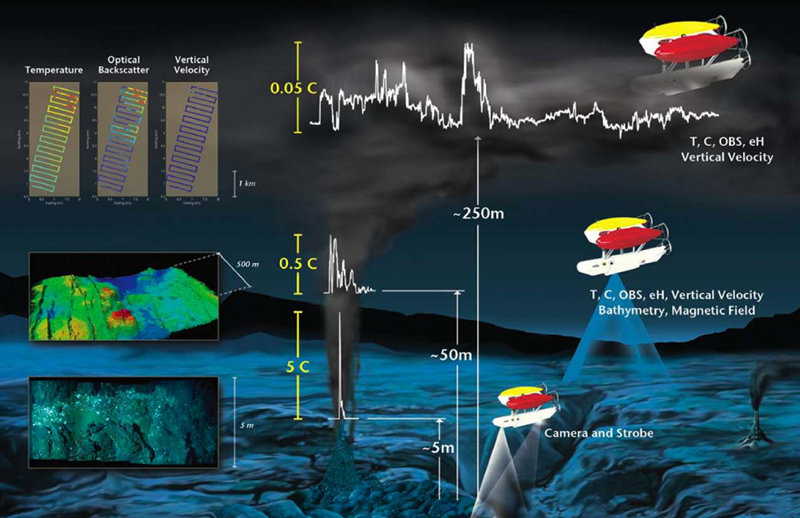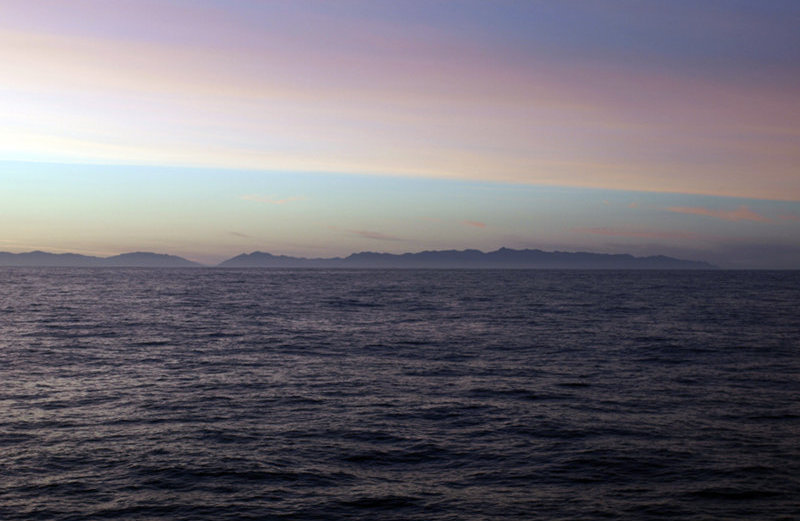
By Chris German
and Dana Yoerger, Woods Hole Oceanographic Institution

First launched in 1995, ABE helped herald a new kind of deep-submergence vehicle – the AUV – and revolutionized deep-sea exploration by expanding scientists’ abilities to reach into the deep. Image courtesy of Dana Yoerger, Woods Hole Oceanographic Institution. Download larger version (jpg, 3.4 MB).
During the first decade of the 21st Century, a new approach to vent-exploration was pioneered using the Autonomous Benthic Explorer autonomous underwater vehicle (ABE AUV) designed and built at Woods Hole Oceanographic Institution (WHOI). One of the major goals of the Census of Marine Life’s ChEss (Chemosynthetic Ecosystems) field program was to answer the question: What controls the biogeography and biodiversity of vent and seep ecosystems? A major barrier to answering that work was the simple fact that we had not located vent-sites in many ocean basins at the start of the last decade and methods of exploration were time consuming and slow. Starting in 2004, therefore, and working closely with NOAA"s Ocean Exploration program, we began a pioneering approach to use AUVs (and, specifically, ABE) to sniff for, map out and ultimately locate and photograph new vent sites in previously unexplored oceans. By 2010, ABE had successfully tracked down more than a dozen new vent-sites in the Pacific Atlantic and Indian Oceans including the world’s hottest vent-site on the Mid-Atlantic Ridge and the world’s first "black smoker" vent to be found on an ultra-slow spreading ridge, in the SW Indian Ocean. On its very last mission, ABE was hot on the heels of new hydrothermal vents at the Chile Triple Junction and the very last data ABE returned to us aboard ship told us we were on the right track.
Animation describing the Autonomous Benthic Explorer (ABE) vehicle. Video courtesy of Woods Hole Oceanographic Institute. Download (mp4, 26.5 MB).
From the in situ Eh sensor as well as the optical sensor on ABE we knew, in 2010, that we had passed through a lens of water rich in particles and "fresh" chemically reducing water indicative of discharge from a seafloor hydrothermal vent. Water column samples collected during that same cruise and analyzed aboard ship and on shore confirmed that this water was enriched in both methane (a chemically reduced compound) and the light isotope of helium, 3He, which is diagnostic of a local release associated with volcanic activity. What was also of concern, however, is that these signals were not associated with clear enrichments in Fe and Mn, metals that are typically also enriched very highly in conventional "black smoker" hydrothermal vents. Why should this be?

Before ABE's first deployment, ABE’s inventors, Al Bradley (left) and Dana Yoerger, tested the autonomous underwater vehicle in the test well at the WHOI dock in Woods Hole. Image courtesy of Tom Kleindinst, Woods Hole Oceanographic Institution. Download image (jpg, 115 KB).

Dawn from the R/V Melville on March 5, 2010. During the 2012 expedition, we'll explore areas discovered by ABE. By the end of the few days onsite, we plan to have an equally exquisite visualization of the underlying seafloor. Image courtesy of Chris German, Woods Hole Oceanographic Institution. Download larger version (jpg, 5.7 MB).
One possibility is that the venting at the southernmost end of the Chile Triple Junction is from an area of seafloor that is blanketed over by sediments from the adjacent continental margin. In normal Mid Ocean Ridges, the sites of venting are far from land and there has not been sufficient time for biological detritus raining down from the sunlit ocean, thousands of meters above, to provide any more than the lightest dusting to cover the young volcanic rocks. At the Chile Triple Junction, by contrast, the ridge is butted right up against the slope of the continental margin that continues up not just 3000m all the way to seaflevel but on, again, to the very top of the Andes mountain range! That means there is a lot of potential for the ridge crest (and any hydrothermal activity it hosts) to be buried alive! Certainly, the new multi-beam maps we collected aboard the R/V Melville in 2010 showed that the ridge crest became progressively more flat and featureless as we headed south with clear volcanic and tectonic terrain giving way to relatively flat and featureless seafloor closest to the Triple Junction itself.
In other locations where venting occurs at sediment covered ridge crests, the nature of the fluids exiting the seafloor is quite different. Instead of "black smoker" fluids at 300-400°C forming chimneys that gush particle-laden jets from the seafloor, much lower temperature vents are seen. For example, in the Escanaba Trough off Oregon, the fluids are closer to 200°C and the metals that were dissolved into the vent-fluids at depth, from young volcanic rock, have all re-precipitated in the pore-spaces of the sediments long before they rise through those soft porous sediments all the way to the seabed. Perhaps something similar will be happening at the CTJ vents? That would certainly be consistent with the high levels of CH4 and He3 but without similarly high levels of Fe and Mn.
In that case, we need to use a different approach, with Sentry, than the methods we used with ABE that always relied on particle-rich (Fe and Mn oxide particles) plumes being present. Instead, it is equally as likely that any fluid flowing up through the sediments may cause a stiffening or cementing of the sediments where the mineralizing fluid flows out of the seafloor but the resulting plumes, which would still be hot and buoyant – so that they would rise up hundreds of meters into the water column before being dispersed "down-stream" by deep ocean currents might not give up clear signals that our optical back-scatter sensors could detect. For that reason, we will unveil a new strategy for vent-exploration on this cruise, using both the sensors that we know have worked previously with ABE and some new added capabilities that have only become available since we introduced Sentry into our Deep Submergence fleet.